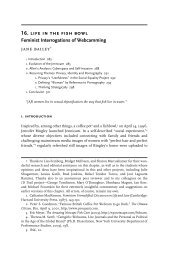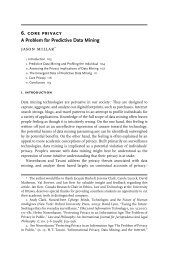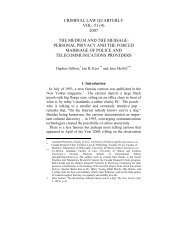Ian R. Kerr Canada Research Chair in Ethics, Law & Technology ...
Ian R. Kerr Canada Research Chair in Ethics, Law & Technology ...
Ian R. Kerr Canada Research Chair in Ethics, Law & Technology ...
You also want an ePaper? Increase the reach of your titles
YUMPU automatically turns print PDFs into web optimized ePapers that Google loves.
<strong>Ian</strong> R. <strong>Kerr</strong><br />
<strong>Canada</strong> <strong>Research</strong> <strong>Chair</strong> <strong>in</strong> <strong>Ethics</strong>, <strong>Law</strong> & <strong>Technology</strong><br />
Faculty of <strong>Law</strong> : Faculte de droit<br />
Common <strong>Law</strong> Section : Section Common <strong>Law</strong><br />
University of Ottawa : Universite d' Ottawa<br />
57 Louis Pasteur St., P.O. Box 450, Stn.A<br />
Ottawa, Ontario K1N 6N5<br />
t 613.562.5800 ext. 3281<br />
f 613.562.5124<br />
iankerr@uottawa.ca<br />
www.ANONequity.org<br />
www.blogonnymity.<strong>in</strong>fo<br />
Anonymity<br />
Historically, the concept of anonymity was associated with a state of namelessness. Be<strong>in</strong>g<br />
an anonym afforded certa<strong>in</strong> advantages. It enabled the nameless to speak without fear of<br />
reprisal, or to engage <strong>in</strong> acts of charity or other forms of benevolence. At the same time,<br />
it made possible wrongdo<strong>in</strong>g without accountability.<br />
With the advent of computer based communications networks, there has been a<br />
resurgence of <strong>in</strong>terest <strong>in</strong> the nature and value of certa<strong>in</strong> types of anonymity. The range of<br />
techniques by which <strong>in</strong>dividuals are able to operate <strong>in</strong>cognito creates a virtual laboratory<br />
for experiment<strong>in</strong>g with the social construction of identity. However, as the <strong>in</strong>ternet’s<br />
surveillance potential becomes better understood and exploited, the measure of one’s<br />
anonymity shifts from its historical focus on names to a broader <strong>in</strong>vestigation of a range<br />
of personal identifiers that can be l<strong>in</strong>ked to an <strong>in</strong>dividual. These <strong>in</strong>clude: date of birth,<br />
marital status, social security number, passport <strong>in</strong>formation, property ownership, vehicle<br />
registration, driver’s license number, facial characteristics, height, email address, place of<br />
bus<strong>in</strong>ess, phone number, credit card history, iris shape, f<strong>in</strong>gerpr<strong>in</strong>ts, ret<strong>in</strong>al image,
employment record, blood chemistry, roadway usage, gait pattern, consumer purchases,<br />
Google search history, <strong>in</strong>ternet protocol address, and the like.<br />
Unbeknownst to many, the <strong>in</strong>creas<strong>in</strong>g ability to l<strong>in</strong>k these identifiers to an <strong>in</strong>dividual has<br />
resulted <strong>in</strong> a dim<strong>in</strong>ished ability to ma<strong>in</strong>ta<strong>in</strong> anonymity, result<strong>in</strong>g <strong>in</strong> applications for<br />
subpoenas and court orders requir<strong>in</strong>g third parties to disclose identify<strong>in</strong>g <strong>in</strong>formation for<br />
the purposes of private lawsuits or police <strong>in</strong>vestigation. In light of the numerous possible<br />
identifiers <strong>in</strong> an <strong>in</strong>formation age, anonymity is perhaps best understood as a state of<br />
disconnection between one’s self and one’s identifiers; a state <strong>in</strong> which data cannot be<br />
associated with a particular <strong>in</strong>dividual, either from the data itself, or by comb<strong>in</strong><strong>in</strong>g it with<br />
other data. The value of anonymity, as Nissenbaum has put it, lies not <strong>in</strong> the capacity to<br />
be unnamed, but <strong>in</strong> the possibility of act<strong>in</strong>g or participat<strong>in</strong>g while rema<strong>in</strong><strong>in</strong>g unreachable.<br />
Anonymity’s ‘unreachability’ provides one means of achiev<strong>in</strong>g West<strong>in</strong>’s conception of<br />
<strong>in</strong>formational privacy: people who are able to disconnect their identities from their<br />
actions are better able to determ<strong>in</strong>e for themselves when, how, and to what extent<br />
<strong>in</strong>formation about them is communicated to others. Although it does not offer seclusion<br />
<strong>in</strong> the usual spatial sense, be<strong>in</strong>g anonymous affords a k<strong>in</strong>d of isolation. Whereas credit<br />
card payments create traceable transactions allow<strong>in</strong>g a consumer’s activities to be tracked<br />
and a data profile to be created, anonymous payments preserve privacy.<br />
Historically, the value of anonymity had less to do with its privacy-enhanc<strong>in</strong>g potential<br />
than its political purpose. Anonymity has always been a crucial thread <strong>in</strong> the fabric of
democracy. Anonymous vot<strong>in</strong>g ensured that citizens were free actors, that their political<br />
participation would rema<strong>in</strong> un<strong>in</strong>fluenced by the tyranny of the majority or by undue<br />
pressure from other powerful groups. The Federalist Papers, a bedrock of U.S.<br />
Constitutional thought, though not truly anonymous, were written pseudonymously us<strong>in</strong>g<br />
a fabricated name to cloak the identities of its authors while still allow<strong>in</strong>g a mediated<br />
form of attribution. The same strategy was later employed by 19 th century female<br />
novelists to prevent gender discrim<strong>in</strong>ation from <strong>in</strong>fluenc<strong>in</strong>g how their work was received.<br />
Now, as then, anonymity enables people to discuss taboo subjects with others. Whether<br />
face-to-face <strong>in</strong> a self-help group or peer-to-peer <strong>in</strong> an onl<strong>in</strong>e chat, sexual abuse, addiction<br />
and disease are regularly confronted and sometimes overcome anonymously. For many<br />
persons, the mere assurance of anonymity is what emboldens them to participate <strong>in</strong> the<br />
first place. Of course, anonymity also enables unlawful associations and anti-social<br />
behaviour, caus<strong>in</strong>g one U.S. Supreme Court Justice to refer to anonymity as the “refuge<br />
of scoundrels.”<br />
In other legal systems, such as <strong>Canada</strong>’s, the ‘refuge’ that anonymity provides is seen as<br />
beneficial for the victims of crimes, impos<strong>in</strong>g restrictions on the publication of their<br />
identities and <strong>in</strong> some cases requir<strong>in</strong>g them to use pseudonyms. Although anonymity is<br />
imposed upon victims with good <strong>in</strong>tentions, it is not always welcome, nor is it always a<br />
viable social solution.
Because anonymity can yield good or bad outcomes, some perceive a conflict regard<strong>in</strong>g<br />
its value and role <strong>in</strong> democratic societies. In the United States, political anonymity is a<br />
constitutional entitlement flow<strong>in</strong>g from the right to freedom of expression and freedom of<br />
association. But the right to anonymous communication is not immutable; it must be<br />
balanced aga<strong>in</strong>st State <strong>in</strong>terests <strong>in</strong> protect<strong>in</strong>g people's reputations, fight<strong>in</strong>g fraud and<br />
crime, and <strong>in</strong> safeguard<strong>in</strong>g national security. Whereas few would disagree that<br />
anonymous vot<strong>in</strong>g is desirable and anonymous crim<strong>in</strong>al activity is undesirable, between<br />
these extremes lies a sea of uncerta<strong>in</strong>ty. Should the <strong>in</strong>ternet support untraceable<br />
transactions? What is an appropriate national encryption policy?<br />
As the <strong>in</strong>ternet cont<strong>in</strong>ues to evolve, anonymity’s future abounds with question marks.<br />
The <strong>in</strong>formation trade has turned dataveillance <strong>in</strong>to big bus<strong>in</strong>ess. Cybercrime legislation<br />
and the expand<strong>in</strong>g ability of law enforcement agencies to collect personal <strong>in</strong>formation<br />
and <strong>in</strong>tercept electronic communications has been proposed or enacted <strong>in</strong> many<br />
jurisdictions, and the demands for identification for everyth<strong>in</strong>g from air travel to build<strong>in</strong>g<br />
entry are on the rise. At the same time, blogs, chat rooms, <strong>in</strong>stant messag<strong>in</strong>g and a<br />
number of other onl<strong>in</strong>e environments provide excit<strong>in</strong>g new venues for social and political<br />
participation that permit and even encourage <strong>in</strong>dividuals to conceal their actual identities.<br />
Millions of people us<strong>in</strong>g them have made clear their desire to withhold disclosure of their<br />
identities for a variety of legitimate social purposes, <strong>in</strong>spir<strong>in</strong>g a number of cryptographers<br />
to develop systems of provable anonymity. The extent to which such applications will be<br />
permitted or adopted by governments or markets <strong>in</strong> the 21 st century rema<strong>in</strong>s uncerta<strong>in</strong>.<br />
Their potential uses and broader questions concern<strong>in</strong>g the importance and impact of
anonymity <strong>in</strong> a networked society are under <strong>in</strong>vestigation by a number of academics and<br />
privacy advocates.<br />
Cross References<br />
See also: Authentication; Identification; Internet Privacy;<br />
Further Read<strong>in</strong>g<br />
Clarke, R. “Introduction to Dataveillance and Information Privacy, and Def<strong>in</strong>itions of<br />
Terms” [Onl<strong>in</strong>e, December 2005] <br />
<strong>Kerr</strong>, I R et al. On the Identity Trail <br />
Marx, G.T. “What's <strong>in</strong> a Name? Some Reflections on the Sociology of Anonymity” The<br />
Information Society 15 (1999): 99-112.<br />
Nissenbaum, H. “The Mean<strong>in</strong>g of Anonymity <strong>in</strong> an Information Age” The Information<br />
Society 15 (1999): 141-144.<br />
<strong>Ian</strong> R. <strong>Kerr</strong>
<strong>Ian</strong> R <strong>Kerr</strong> holds the <strong>Canada</strong> <strong>Research</strong> <strong>Chair</strong> <strong>in</strong> <strong>Ethics</strong>, <strong>Law</strong> and <strong>Technology</strong> at the<br />
University of Ottawa, Faculty of <strong>Law</strong>. He has published writ<strong>in</strong>gs <strong>in</strong> academic books and<br />
journals on ethical and legal aspects of privacy, digital copyright, automated electronic<br />
commerce, artificial <strong>in</strong>telligence, cybercrime, nanotechnology, <strong>in</strong>ternet regulation, ISP<br />
liability, and onl<strong>in</strong>e defamation. His current program of research <strong>in</strong>cludes On the Identity<br />
Trail, supported by one of the largest ever grants from the Social Sciences and<br />
Humanities <strong>Research</strong> Council, focus<strong>in</strong>g on the impact of <strong>in</strong>formation and authentication<br />
technologies on our identity and our ability to be anonymous.







